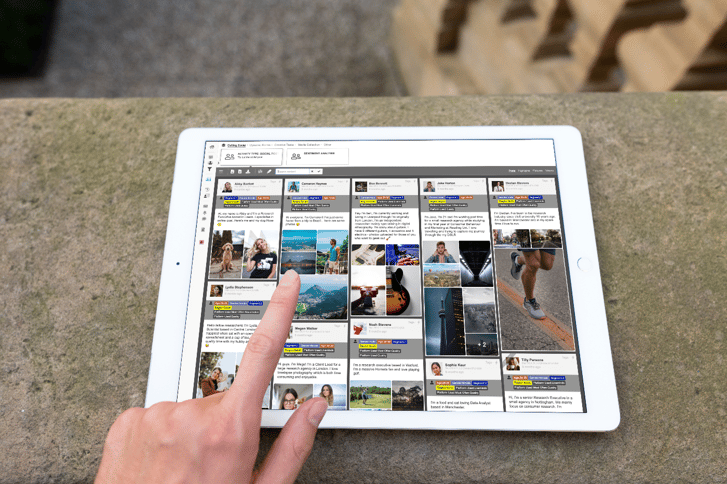Qualitative Research 101: Everything you need to know

Contents
If you are keen on learning more about qualitative research, it can be hard to find an overview of all the key things you need to know, and how to apply everything that is available in the qualitative research sphere to your particular needs. This article has been designed to be that overview - a "pillar page" that will provide everything you need to know before spreading your search further into specific areas that interest you or that directly relate to what you are trying to achieve using the latest qualitative research tools and methods.
In this article you will discover:
- The difference between qualitative and quantitative research
- The difference between online and offline qualitative research
- Common qualitative research methodologies
- The powerful market research trend towards video
- that is changing the qualitative research landscape
- Modern approaches to qualitative data analysis
- How to choose qualitative research software
When talking about research methods, there are generally two distinct styles of research that need to be considered - qualitative and quantitative. Any discussion about qualitative research, what it is, and how it can be used inevitably must also consider how it is different from quantitative research - so that is where we will begin!
Qualitative vs quantitative research
Quantitative research: All about the numbers
Quantitative research is most often associated with the social sciences, natural sciences, and business administration. It often involves measuring the impact of certain events on a population. Specifically, it is research that measures something with numbers.
For example, in medicine, a researcher might investigate the efficacy of a new vaccine on patients by conducting a quantitative research study. A simpler example might be finding out how many people have heard of a particular brand, and how many like the brand.
Data collection for quantitative studies is often through running Web surveys, and there are a large number of platforms available to create such surveys, ranging from the relatively cheap Survey Monkey through to Confirmit and Qualtrics at the high end.

Due to the nature of quantitative research - the collection and analysis of numbers - research is heavily biased towards online methods, and data analysis takes advantage of all the intrinsic benefits of computers ("crunching" large amounts of data, performing analytics to uncover trends and producing digestible summaries of big data sets).
Qualitative research: Analysis of non-numerical data
Qualitative research is literally everything quantitative research is not. It involves the collection and analysis of non-numerical data (e.g., text, video, audio). Rather than resulting in "statistics", it results in "insights" (i.e. it helps to understand concepts, opinions, or experiences). The goal is often to delve into what problems exist or to generate new ideas for research.
The purpose of qualitative research is to "explain rather than describe". Qualitative research projects are often exploratory rather than explanatory, aiming to explore phenomenon rather than test a hypothesis. As such, the research may be used to generate or contribute evidence towards new hypotheses.

One of the biggest concerns when conducting qualitative research is sampling. Because most studies aim to understand a larger group through intensive observation (e.g. ethnography), samples are typically smaller than in quantitative research where random sampling is more common. Sampling may also be more purposive rather than random. Participants may be selected by convenience, snowball, or judgemental methods, which raises concerns that findings cannot be generalised beyond the sample.
An effort is usually made to avoid this problem by collecting data from multiple, diverse sources and triangulating findings so that different perspectives are considered at the same time. Rather than looking for statistical significance in the results, "thematic findings" are what is important in qualitative research.
Factors to determine your sample size for qualitative research
Qualitative research is often overshadowed by quantitative research due to the sheer size of the quantitative research industry, and the ease with which the benefits of quantitative methods can be understood and applied. The broadness of qualitative research is both a strength and a weakness. While it provides insights that are impossible to get through numbers, the broadness of approaches and the ever-improving suite of tools and technologies available can make it harder to understand (and keep up with).
Gaining an understanding of qualitative research methods and approaches and applying them to your clients can distinguish you from your competitors, so it is certainly worth the effort to understand what is possible. Providing something different, and better, that results in deeper insights is always going to be of greater value than a "quant only" offering.
The best way to expand your quant-based research firm is to move into qual and provide a hybrid approach that gives clients the best of both worlds. Because of the more open-ended and emergent nature of the qualitative inquiry, the field is more amenable to using mixed-methods approaches. For instance, researchers can use a qualitative methodology such as ethnography to guide the focus of a larger, quantitative survey.
How to conduct qualitative market research successfully
Online vs. offline qualitative research
The qualitative research methods being used most commonly today fall into two distinct "camps" - online and offline. Online qualitative research is defined as research where the qualitative data is collected "digitally" - usually over the Internet. Offline research is where more traditional data collection methods are used involving physical contact between moderators and participants.
Online research methods are on the rise
Online research is on the rise because it enables fast and wide-scale access to participants (e.g. through social media recruitment) without needing any specific fieldwork abilities (e.g. recruiting on the street). Furthermore, it enables researchers to be more flexible with whom they can communicate with (e.g. online focus groups that involve geographically remote participants).
Advantages of online research: Why you should move your project online
Due to these advantages, more and more researchers are embracing digital technologies for at least some of their qualitative research data collection. Lastly, it can be argued that digital research not only enhances but also move beyond traditional qualitative methods such as interviews and observations.

As with any form of research, it is important to take all of the key advantages and disadvantages of going online into account before making a final decision about which way to take a particular project.
The top 7 advantages of online research
- Data can be collected from anywhere in the world (e.g., recruitment through social media)
- Approach participants quickly and with minimal costs (e.g., data is crowd-sourced)
- Data can be analyzed automatically (e.g., using an online platform that analyses textual data such as words and phrases used or frequency of self-reported emotions).
- Enables researchers to be more flexible with whom they can communicate with (e.g., online focus groups)
- Allows researchers to easily create their own coding schemes when using specific platforms for data collection.
- Data provides insight into unmeasured or under-researched phenomena that are not typically covered by traditional qualitative methods (e.g., consumer loyalty)
- The ability to protect anonymity and confidentiality of respondents due to its largely distance-based nature
Offline qualitative research methods are still important
Online research is never going to completely replace offline methods. Regardless of any other reasons, online methods are simply not right for every circumstance.
Critics of online research believe that the main disadvantages in collecting qualitative data digitally are related to the quality and reliability of the data being collected. Some of their specific concerns are:
- That without in-depth knowledge about how these platforms work, researchers might not be able to prevent participants from breaking their anonymity rules for example.
- In some cases it is difficult if not impossible for researchers to identify who exactly is behind a certain set of data.
- Data which is collected online will most likely only give one interpretation, since there is no way to verify what respondents mean/intend by their responses .
- Because of the lack of control over study participants (e.g. drop out rates), drawing definitive conclusions about phenomena becomes harder.
What is interesting about all of these concerns is they all appear to be the result of poor platform choice, platform training, or project management. For researchers who what to take the lead into online research, a key point from all of these concerns is going online requires both careful research and personal commitment to make these online research methods work.
How to choose qualitative research software
The reason offline qualitative research will continue to be important has nothing really to do with pitfalls of going online that can be avoided with the right platform and training. It has much more to do with the simple fact that offline will always be better in certain circumstances. An example would be a taste test or a group trial of a physical product where initial reactions are key.
Common qualitative research methodologies
Qualitative research methods are designed to discover what people "think" about a particular topic. It can involve looking at how they behave, and what their perceptions are. While there are many different types of research that can be classed as "qualitative research" - including things like document analysis - here we will focus on the main types of research requested from market research professionals by their clients.
In-depth interviews
These are known by various names - including one-on-one interviews and "IDIs". This method involves directly asking research participants questions in order to gain their opinions on specific subjects.

Focus groups
Focus groups are one of the more commonly used qualitative research methods, and they play an important role in many qualitative research projects. A focus group usually includes a relatively small group of respondents (usually between 6-10) who will meet together either (i.e. in a "group") in person or virtually on a zoom call or through an online platform.

The use of a focus group has some benefits and some disadvantages when compared to one-on-one interviews as discussed below.
Advantages over in-depth interviews
- Focus groups allow for more people to be covered in a shorter period of time so you can reach more people outside your group faster than you could with just one-on-one interviews
- Because multiple people are involved it's easier to see how certain people may affect others' thoughts and opinions
- It allows for a much faster response time because all of your information is being collected from multiple sources at once.
Disadvantages to in-depth interviews
- Much can be lost in translation when trying to interpret everyone's answers
- Much depends on the quality and experience of the moderator
- It may be difficult for people who are interacting with other people to remain completely unbiased.
Taking focus groups online is one of the key "battlegrounds" between online and offline research methods. There is a lot to consider when deciding if taking your next project online is a good option.
Online consumer research panels: Are they the right method for your next project?
Ethnography
Another common method of qualitative research is known as "Ethnography". This type of research involves immersing yourself within a group or culture for an extended period of time.
For example, you might want to learn about the daily life of teenagers living on their own or what it's like to be a stay-at-home mom.
%20(1).png?width=683&name=Qualzy%20Blog%20Images%20(600%20x%20338%20px)%20(1).png)
Online-specific research methodologies
The research methodologies that we have discussed above all have a common trait - they existed before online research was even an option. There is a long history of these research methods being used, and the move to online for all of these methodologies does not change their fundamental structure and purpose.
For example, video groups on Zoom and other video-based platforms can replicate focus groups and one-on-one interviews. These are still essentially the same "methodologies" - they are just conducted online rather than offline.
New online methodologies
The rise of online research has led to the creation of a whole series of new online tools that have created opportunities for completely new methodologies that have no equivalent in the offline research world. Since they have been designed specifically for online, they provide an optimised digital experience for participants.
Online discussions
Online discussions can have many different names, including bulletin boards, forums and short-term communities. Regardless of what they are called, they all have the same traits:
-
They generally have between 10-60 participants (though they can have more)
-
The discussion is run over a few days of weeks
-
Generally there will be a couple of activities each day to complete
-
A moderator will probe participants for further information or engage with them in other ways to help get deeper insights
-
Participants may be able to engage with each other to give more of a "community feel" to a particular activity.
-
Advanced activities - like ideations - may provide specific functionality for certain types of research that can be conducted within a wider discussion project.
Online discussions can be accessed on any modern device - including mobile phones, tablets and laptops - making access easy regardless of where a participant is at any particular time. This makes them perfect for longer term research that will need participants to be involved for multiple days or weeks. Such involvement would be impossible in the "real world" because the amount of time that would have to be allocated to performing activities in person would be impossibly high.
The technologies available to you to complete online discussions is extensive, with a number of platforms offering suites of 15 or more activity types for all types of data collection. These collection methods can be mixed and matched to create a more engaging experience for the people taking part - perhaps a video and a quick poll today, followed by a pin task and some picture taking tomorrow.

Long-term communities
For many years, long-term communities were simply "panels". They existed mainly as a pool of people that could be used as respondents to Web surveys. Qualitative research wasn't part of the research process, and these panels were just a means to get the people required to collect quantitative data.
Over the years, as qualitative research grew online, qualitative researchers started see whether they could run a qualitative study as a semi structured project directly from within these panels. What they found was using a new research method with people who were used to Web surveys meant they didn't always get the quality of results they expected.
This has led to the growth of something designed to be used in qualitative research from the very start - smaller panels of people (as small as a few hundred up to a thousand people in total) specifically recruited to provide valuable qualitative insights for a long period of time.

Long-term communities differ from short-term communities (i.e. discussions) in a number of ways:
- Discussions tend to be very structured - e.g. three days of activities, with four activities on each day. Long-term communities are much less structured - "add a task whenever needed" is a common approach. Clients often use a long-term community as an easily accessible pool of people to ask opinions of at a moment's notice.
- Discussions are very "ad-hoc" - it's all over in a matter of days or weeks. Long-term communities are much more of a commitment for participants. They feel more like their own Web site, and things like logins, ongoing rewards and additional content like blogs are much more common.
- Discussions are quicker to set up and recruit for, but once they are done, the recruits are gone. Each discussion usually needs to be recruited for all over again. Long-term communities require more set up including theming and various content pages, but once set up and recruited for you don't necessarily have to recruit again - you keep going back to the same pool of people.
From a qualitative research perspective, the thing that is the same regardless of whether you are doing a short-term or long-term community is the suite of activities available to you.
The powerful market research trend towards video
We live in a world right now, however, where the speed of change is being forced upon a market research professional is much faster than normal. Remote working has become much more common, and all manner of research (for example - tracking a customer journey) has had to be adjusted to consider new restrictions on practical aspects of conducting market research - particularly in terms of how data collection will need to be done.
Online research has primarily grown through the use of technology to add to the existing research methods in ways that can not be replicated in the "real world". Huge scale, the ability to leverage social media, and the ability to crunch a lot of data are just some of the things that have made certain online research methods so important for literally decades.
As an increasing slice of new projects moves online, the replacement for "in-person" will primarily be "on video". It will be easier to get participants (because being in the vicinity of a central location is no longer necessary, and attending virtually is less of a "hassle"), and moderator location is also unimportant. Incentives can be less, and some costs - like the cost of a group room - will disappear completely.
Understanding the bigger picture by including video as part of any research project is considered to be extremely important by clients who want to make informed decisions, understand the biggest trends and get a better understanding of what various different types of people think - regardless of whether they are looking at consumers online through, people using social media, employees of many companies or anyone else. Video is almost always a powerful tool to go beyond text-based responses.
As the amount of video being collected grows, and the level of analysis and quality of expected outputs also becomes higher - this all begs the question... how is this even achievable? Watching hours and hours of video and trying to make sense of it all is extremely time-consuming, so manually solving this problem is expensive at best, and near-impossible at worst.
Fortunately, analysis of the ever-growing amount of video being collected is made feasibly through the use of automated "video analytics". Harnessing these new technologies has been made possible by taking the capabilities of Google, Microsoft, Amazon and others, and using them as building blocks to create a solution that is specific to market research.
The 3 Market Research Trends taking the industry by storm
Modern approaches to qualitative data analysis
The process of analyzing data and your research findings is critical when it comes to making decisions; this is why it's vital you make the process of analysing qualitative data as easy and as simple as possible.
Traditional analysis is undertaken by researchers while in the room with focus groups or conducting the interviews - benefiting from the social context of being able to read and individuals emotions and keep participants from straying off course. The quality of the analysis is directly related to the skill and experience of the researchers themselves, which can be a limiting factor.
Online approaches to qualitative study help foster creativity and ingenuity - with researchers always looking for new ways of engaging with participants. The great thing about modern online data analysis is that sky is indeed the limit in terms of developing new ideas and methodologies when collecting data and how to analyse it.
Qualitative analysis does not need to take up your time - modern approaches enable you to receive responses in real-time so that you can start to analyze data right from the get-go. As part of any campaign, you should be given access to a dashboard that provides you with the tools to start your data analysis.
Your dashboard is the start of your qualitative data analysis and shows you how your sample is responding or engaging to your research questions; it'll display all data collected and the level of engagement from your sample.
The modern approach of using a dedicated platform empowers the researcher to track respondent behaviour and the wider community.
How to make qualitative data analysis easy and simple
How to choose qualitative research software
Any venture into the world of online qualitative research necessitates to use of a platform to create and run your projects. Finding the right platform can be a daunting task, but there are a few basic things to consider when taking this journey of discovery.
Avoid lock-in to untried solutions
Unfortunately, we live in a world where "subscriptions are king" and locking you into a particular platform - preferably for a few years - is the end goal of many platform providers. Big promises linked to a long-term commitment or large upfront costs are quite common.
There is no need to lock into anything, ever, if you don't want to. A number of providers will offer very reasonable per-project pricing that will not only suit your existing project but will also let you try the platform, set up your project design, and show your client a preview of what they will be getting before making you pay for anything. Providers who are happy to back their platform and show you everything you need to make an informed decision without trying to first lock you in are the ones to look for.
How to choose qualitative research software
Ensure you will get the support you need
Even the best qualitative research platforms can fall down due to poor support - particularly when you are new to the platform. Confirm what support is provided - and if it costs extra factor this into your costs. Online research often requires quick support response times - particularly when you are dealing with real-time research like a live group.
There are various levels of support available, but some of the things to look out for:
-
You may be able to get free setup included for your first project - some suppliers offer this to help make this first experience as smooth as possible, and to help you get the most out of the platform from day one.
-
Some platforms give you instant access to the support team through an online chat. Often this is also a great way to get quick access to their knowledgebase.
-
When looking at testimonials for a platform, pay particular attention to what is said about support - the quality and level of support is hard to gauge prior to getting involved in a project (it's easy to promise good support - harder to confirm the promises).
Try to discover the true capabilities of a platform
At first glance, all platforms can seem very similar. Same promise about how great they are. Similar list of qualitative research methods is available to you. Similar indications that they would be perfect for "you". The trick is to look around the edges of all these claims to determine whether what you need is truly available. Examples of things to consider are:
- Does the platform use an app on phones and tablets? A few years ago apps were necessary to support some of the more advanced activities, however advances in browsers make them redundant nowadays, so all you are left with is their limitations. If they don't install as expected or crash when running, fixing the specific issue with a specific device is near impossible. Completely browser-based solutions can be used by participants on any device from a single link. Access is instant, and if a device is playing up, simply move to another one.
- Does the platform do what you want with videos? This point leads on from what we discussed earlier in this article - the rise of video in qualitative research. If you don't need video, or you just want to collect the video and deal with it yourself this is not a big issue - all platforms will do that. If, however, the idea of video analytics excites you (and more importantly your clients) make sure you pick a platform with powerful analytics features. All platforms will offer some sort of text transcription - the question is whether they go beyond that to identify sentiment and themes, and whether they help you build showreels (often also known as highlight reels).
- Does the platform cost rise steeply as the number of participants or days rise? Platforms can often appear to be around the same price, but always make sure you get a final price based on your exact needs. So of the pricing offered by platforms is for as few as 10 participants, while other platforms provide the same price all the way to 200 participants. If you have a discussion with 50 participants, the final cost between these platforms is likely to be substantial.